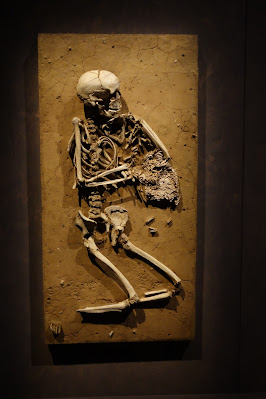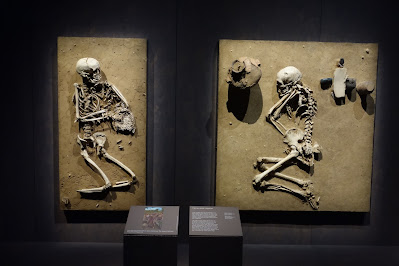Today we saw the fascinating new exhibit at the British Museum. Stonehenge was built between 5,000 and 3,500 years ago. To this day no one knows exactly why the monumental stone circle was built. This museum exhibition attempts to understand Stonehenge by looking at the changing relationships of people with the sky, earth and each other in Great Britain, Ireland and Europe at that time, so very long ago.
 |
The Gleninsheen gold collar 800-700 BC. Discovered in
1932 in Ireland, it was likely worn by individuals to display their wealth and power.
Gold was introduced to Britain and Ireland from Europe around 4,500 years ago.. |
 |
| Stone axes |
 |
| A rare complete stone axe preserved in a Scottish peat bog |
 |
Wild cattle were once common in the woodlands of Europe .
but were hunted in Britain to extinction. This skull is from
an animal struck that was struck so forcefully with a stone axe that
part of the blade was lodged in its frontal bone. |
 |
| An interesting digital display in the exhibit |
 |
A 5,000 year old chalk stone "drum" found in a children's
graveyard in east Yorkshire. |
 |
Around 5,00 years ago communities in Britain, Ireland
and Europe expressed connections through a new type
of art using spirals, circles and geometric patterns.
|
 |
Seahenge, a British prehistoric monument
dating back to over 4,000 years discovered in 1988.
Its purpose, like Stonehenge, remains a mysery. |
 |
| A gold cape found in Wales. |
 |
Curious gold cone-shaped hats decorated with solar motifs.
found in Europe. |
 |
The Nebra Sky Disk, the world's oldest map of the stars.
It is around 3,600 years old and was found in Germany. |
 |
| An amber cup around 1550 BC found in Brighton, Sussex |
 |
Spooky wooden carvings around 1200 BC
found in Yorkshire |
 |
Mounting pressure from trade wars and new land divisions
gave rise to warfare across northwest Europe
around 3300 years ago. |
 |
| Pointed Bronze Age helmets |
 |
| Bronze musical horns found in an Irish bog. |
 |
Crotals (tear-shaped rattles) containing a piece of baked clay or pebble.
and possibly used to incite warriors to battle and intimidate the enemy.
|
 |
This cauldron 800-600 BC was used to cook meat for a feast
was found in the River Thames |
 |
Tridents from the Irish Sea.
Their purpose is speculative. |
 |
| Stone jewelry |
 |
| Another view of Seahenge free-standing timber circle |
 |
| Remains of victims from the Bronze Age battle at Tollense |
 |
| Time for a scone from nearby Ruskin's Cafe! |














































John, can you retain all this information from the Bronze age but anyone that loves history would enjoy these pictures.
ReplyDelete